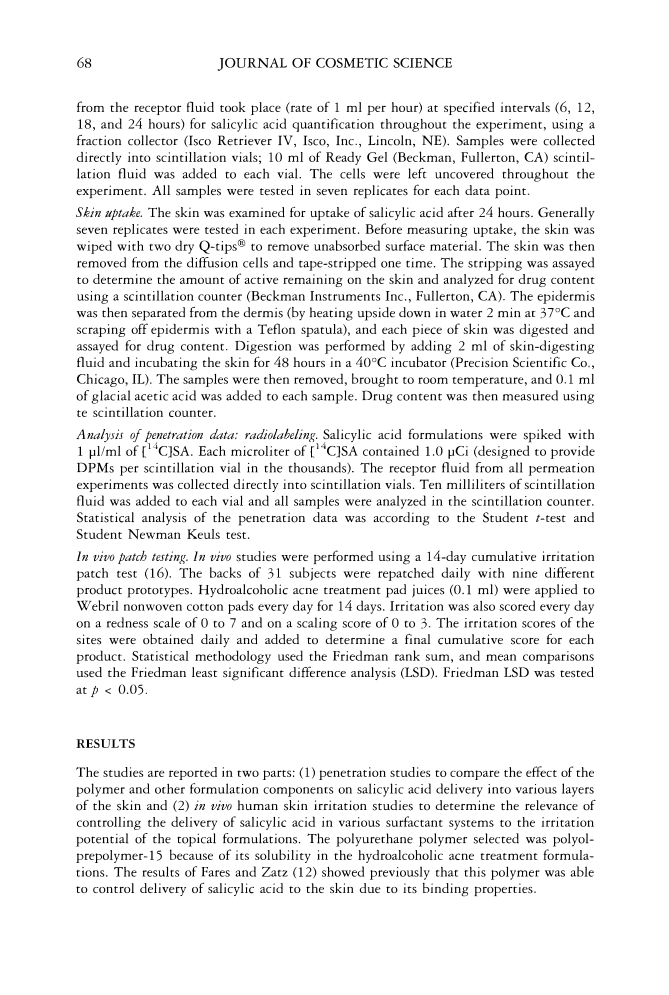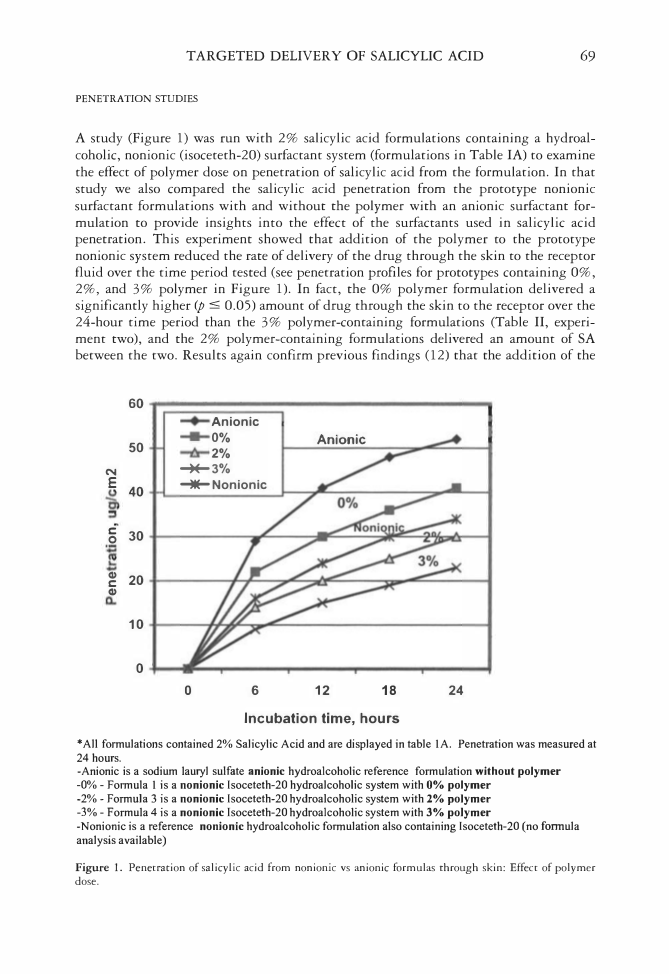68 JOURNAL OF COSMETIC SCIENCE from the receptor fluid took place (rate of 1 ml per hour) at specified intervals (6, 12, 18, and 24 hours) for salicylic acid quantification throughout the experiment, using a fraction collector (Isco Retriever IV, Isco, Inc., Lincoln, NE). Samples were collected directly into scintillation vials 10 ml of Ready Gel (Beckman, Fullerton, CA) scintil lation fluid was added to each vial. The cells were left uncovered throughout the experiment. All samples were tested in seven replicates for each data point. Skin uptake. The skin was examined for uptake of salicylic acid after 24 hours. Generally seven replicates were tested in each experiment. Before measuring uptake, the skin was wiped with two dry Q-tips® to remove unabsorbed surface material. The skin was then removed from the diffusion cells and tape-stripped one time. The stripping was assayed to determine the amount of active remaining on the skin and analyzed for drug content using a scintillation counter (Beckman Instruments Inc., Fullerton, CA). The epidermis was then separated from the dermis (by heating upside down in water 2 min at 3 7 ° C and scraping off epidermis with a Teflon spatula), and each piece of skin was digested and assayed for drug content. Digestion was performed by adding 2 ml of skin-digesting fluid and incubating the skin for 48 hours in a 40°C incubator (Precision Scientific Co., Chicago, IL). The samples were then removed, brought to room temperature, and 0.1 ml of glacial acetic acid was added to each sample. Drug content was then measured using re scintillation counter. Analysis of penetration data: radiolabeling. Salicylic acid formulations were spiked with 1 µ1/ml of [14CJSA. Each microliter of [1 4 CJSA contained 1.0 µCi (designed to provide DPMs per scintillation vial in the thousands). The receptor fluid from all permeation experiments was collected directly into scintillation vials. Ten milliliters of scintillation fluid was added to each vial and all samples were analyzed in the scintillation counter. Statistical analysis of the penetration data was according to the Student t-test and Student Newman Keuls test. In vivo patch testing. In vivo studies were performed using a 14-day cumulative irritation patch test (16). The backs of 31 subjects were repatched daily with nine different product prototypes. Hydroalcoholic acne treatment pad juices (0.1 ml) were applied to Webril nonwoven cotton pads every day for 14 days. Irritation was also scored every day on a redness scale of O to 7 and on a scaling score of O to 3. The irritation scores of the sites were obtained daily and added to determine a final cumulative score for each product. Statistical methodology used the Friedman rank sum, and mean comparisons used the Friedman least significant difference analysis (LSD). Friedman LSD was tested at p 0.05. RESULTS The studies are reported in two parts: (1) penetration studies to compare the effect of the polymer and ocher formulation components on salicylic acid delivery into various layers of the skin and (2) in vivo human skin irritation studies to determine the relevance of controlling the delivery of salicylic acid in various surfactant systems to the irritation potential of the topical formulations. The polyurethane polymer selected was polyol prepolymer-15 because of its solubility in the hydroalcoholic acne treatment formula tions. The results of Fares and Zatz (12) showed previously that this polymer was able to control delivery of salicylic acid to the skin due to its binding properties.
TARGETED DELIVERY OF SALICYLIC ACID 69 PENETRATION STUDIES A study (Figure 1) was run with 2% salicylic acid formulations containing a hydroal coholic, nonionic (isoceteth-20) surfactant system (formulations in Table IA) to examine the effect of polymer dose on penetration of salicylic acid from the formulation. In that study we also compared the salicylic acid penetration from the prototype nonionic surfactant formulations with and without the polymer with an anionic surfactant for mulation to provide insights into the effect of the surfactants used in salicylic acid penetration. This experiment showed that addition of the polymer to the prototype nonionic system reduced the rate of delivery of the drug through the skin to the receptor fluid over the time period tested (see penetration profiles for prototypes containing 0%, 2%, and 3% polymer in Figure 1). In fact, the 0% polymer formulation delivered a significantly higher (p 0.05) amount of drug through the skin to the receptor over the 24-hour time period than the 3% polymer-containing formulations (Table II, experi ment two), and the 2% polymer-containing formulations delivered an amount of SA between the two. Results again confirm previous findings (12) that the addition of the 60 Anionic 0% Anionic 50 2% N �3% E 40 �Nonionic C 30 0 G 20 C G 10 0 0 6 12 18 24 Incubation time, hours *All formulations contained 2% Salicylic Acid and are displayed in table IA. Penetration was measured at 24 hours. -Anionic is a sodium lauryl sulfate anionic hydroalcoholic reference formulation without polymer -0% - Formula 1 is a nonionic lsoceteth-20 hydroalcoholic system with 0% polymer -2% - Formula 3 is a nonionic Isoceteth-20 hydroalcoholic system with 2% polymer -3% - Formula 4 is a nonionic Isoceteth-20 hydroalcoholic system with 3% polymer -Nonionic is a reference nonionic hydroalcoholic formulation also containing Isoceteth-20 (no formula analysis available) Figure I. Penetration of salicylic acid from nonionic vs anionic formulas through skin: Effect of polymer dose.
Purchased for the exclusive use of nofirst nolast (unknown) From: SCC Media Library & Resource Center (library.scconline.org)





































































































































